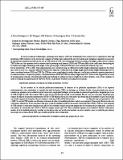Por favor, use este identificador para citar o enlazar a este item:
http://hdl.handle.net/10261/44796COMPARTIR / EXPORTAR:
 SHARE
BASE SHARE
BASE
|
|
| Visualizar otros formatos: MARC | Dublin Core | RDF | ORE | MODS | METS | DIDL | DATACITE | |

| Título: | Study of the relationship between total egg production, female spawning stock biomass, and recruitment of Flemish Cap cod (Gadus morhua) |
Otros títulos: | Estudio de la relación entre la producción total de huevos, la biomasa de hembras reproductoras y el reclutamiento del bacalao (Gadus morhua) de Flemish Cap | Autor: | Pérez-Rodríguez, Alfonso CSIC; Morgan, M. Joanne; Rideout, R. M.; Domínguez-Petit, Rosario CSIC ORCID; Saborido-Rey, Fran CSIC ORCID | Palabras clave: | Reproductive potential Recruitment Fecundity Maturation Sex ratio |
Fecha de publicación: | 2011 | Citación: | Ciencias Marinas 37(42): 675-687 (2011) | Resumen: | In stock-recruitment relationships, spawning stock biomass (SSB) has traditionally been assumed to be equivalent to total egg production (TEP); however, in the last decade a number of studies have indicated the need to include more biological complexity in measures of reproductive potential and advocate the use of TEP instead of SSB. The relationship between fecundity and length is often used to estimate TEP. In that case, the equations used to estimate female spawning stock biomass (FSSB) and TEP only differ in the coefficients determining the fecundity and weight relationships with length. In the present paper, TEP and FSSB have been estimated for Flemish Cap cod (Gadus morhua) for the period from 1978 to 2008. Total egg production was calculated using six different fecundity-length relationships applied to the whole time series in each case. A greater difference between the allometric coefficient in the weight-length and fecundity-length relationships led to a lower correlation between FSSB and TEP. The TEP time series using higher fecundity allometric coefficients explained a greater proportion of recruitment variance. Despite this pattern, correlation between FSSB and TEP was always higher than 0.96. These results support the necessity of making annual estimates of potential fecundity and studying its relation not only to length but to other variables, such as fish condition, in order to really get an improvement of TEP over FSSB as a predictive variable in recruitment assessments. | URI: | http://hdl.handle.net/10261/44796 | E-ISSN: | 0185-3880 |
| Aparece en las colecciones: | (IIM) Artículos |
Ficheros en este ítem:
| Fichero | Descripción | Tamaño | Formato | |
|---|---|---|---|---|
| Saborido-Rey.pdf | 361,86 kB | Adobe PDF |  Visualizar/Abrir |
CORE Recommender
Page view(s)
301
checked on 23-abr-2024
Download(s)
250
checked on 23-abr-2024
Google ScholarTM
Check
NOTA: Los ítems de Digital.CSIC están protegidos por copyright, con todos los derechos reservados, a menos que se indique lo contrario.
